While the Rivers Task Force of the dozen downstream Florida counties is looking for something to do to help, Valdosta clearly hasn’t yet done enough to stop its sewage spills, but they are doing more. Here’s some context that may indicate what might help. Spoiler: water quality monitoring, funding for further fixes, and enforcement if necessary. Unless raw sewage spills really are what Valdosta wants to be known for in Tallahassee and Atlanta.
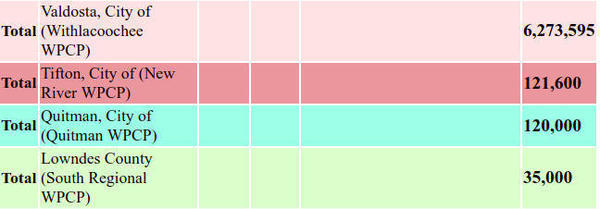
See
Valdosta December 2018 sewage and Hamilton County, FL legislative delegation 2019-01-16″>
Also: come on up and talk to the Valdosta City Council. Merrillee Malwitz-Jipson did, and it got their attention. They keep hearing from me for years now, and it helps to see somebody directly affected downstream come up and speak.
This post is mostly about two Valdosta City Council meetings, that included much discussion of the recent Valdosta wastewater spills, on on December 6, 2018 and January 24, 2019, as well as some important events between and afterwards.
But first, what they haven’t talked about yet in those meetings.
Not yet mentioned in Valdosta City Council
Valdosta City Council Tim Carroll sent a summary of Valdosta actions since their early December wastewater spills. It includes this big item:
2. We also discussed building another catch basin. Almost doubling our storage capacity during storm events. This will be about $1-1.5M so it is not a budget buster.
Since then I hear they’re discussing with the nearby landfill owner a deal of dirt for digging that would further reduce the cost. Apparently they don’t want to bring up this catch basin at a City Council meeting until they have a plan for it with a budget.
I appreciate Council Carroll’s communications. It works both ways: he had not heard about the dozen other Valdosta spills until I told him. He is well aware of my opinion that if Valdosta wants to stop having a reputation of hiding information, it needs to stop hiding information important to the public health.
Valdosta City Council 2018-12-06
The most-discussed general topic on the agenda was water, with Utility Director Darryl Muse speaking about bids for 10 emergency standby generators, water treatment chemicals, and a SCADA system for Lift Stations and Water Treatment Plants, with frequent questions from Council members. They did bring up the recent major spill at the Withlacoochee Wastewater Treatment Plant. They approved more than half a million dollars for those improvements.
In Citizens to Be Heard, I told them what Valdosta Utilities hadn’t: the dozen other spills Utilities hadn’t even told Valdosta City Council about.
For the complete meeting, see Videos: SCADA and Generators for sewer system lift stations @ VCC 2018-12-06.
-
5.b. Bids for 10 emergency standby generators for Utilities

Video. Valdosta Utilities Director Darryl Muse apologized for not being dressed up as usual, because he had been out in the field dealing with leaks in the rain. He had originally intended to ask for five, but he discussed budget and he and City Manager Mark Barber decided to go ahead with then. He asked for $224,901.50 plus 10% contingency, which would be another $22,490.15, for $247,391.65 grand total.
There was much discussion with Council members about where the generators would be used, local power there, wastewater storage, etc. On average, Valdosta has about 90 minutes of storage at each lift station and personnel on call faster than that. That’s about 10-15,000 gallons at a typical station; more at bigger ones.
The requested funds passed unanimously.
-
5.c. Bids for water treatment chemicals for Utilities

Video. These chemicals were for processing both drinking water and wastewater. This is a routine negotiation with bidders. I didn’t catch what the dollar amount was.
-
6.b. Purchase SCADA system for Lift Stations and Water Treatment Plants

Video. It’s good Valdosta is getting a Supervisory Control and Data Acquisition (SCADA) system for constant monitoring and fast internal notification, such as unusual pump runtimes. But why didn’t they already have one? What else don’t they have that the should have already gotten? At least Director Muse said he planned to come back for more next year (2019) to tie in all the rest of Valdosta’s wastewater facilities. He said option 3 was $292,459. There was some discussion of other improvements they had already made. Then on a motion by Council Tim Carroll, they unanimously approved that amount. Added to the generators for lift stations, that’s $539,850.65 in sewer system improvements approved by the Valdosta City Council in one meeting.
Mayor John Gayle remarked that in about 160 meetings since he has been Mayor, he didn’t remember a single one when they didn’t discuss something to improve their water treatment situation.
-
8. CTBH Help get GA-EPD to publish sewage spill reports –John S. Quarterman

Video. I invited them to paddle with WWALS , as I always do.
Utilities hadn’t told Council, so I did: there were thirteen more spills than just the one from the WWTP, as WCTV carried me saying that around that same hour of the evening. I also asked the Valdosta City Council to help get GA-EPD to publish sewage spill reports.
Mayor John Gayle indicated Valdosta reported to the state and I could get the reports from there. I said that was the point: that’s how I found out about the 13 spills Utilities didn’t tell anybody else about.
At least he didn’t laugh, like he did in March 2017.
Meanwhile
Many of those dozen other spills still weren’t stopped days later.
GA-EPD surprised everyone, as I told the Valdosta City Council next time I spoke to them. That GA-EPD surprise made it easier for me to find that Valdosta spilled a couple more million gallons of raw sewage. I mentioned that, too.
WWALS invited affected downstream people to come speak at the next Valdosta City Council meeting, and one person came and did that.
Valdosta City Council 2019-01-24
After a composite vehicle bid item, the second longest item, at almost four minutes, was Merrillee Malwitz-Jipson, who came from Florida, speaking in CBTH about Florida effects of Valdosta Sewage. Ms. Tooley stopped her precisely at three minutes, but City Manager Mark Barber took most of a minute thanking her for coming to speak. He confirmed that Valdosta officials would be at the next Suwannee River Water Management District (SRWMD) board meeting. Council Tim Carroll and Ms. Tooley also thanked the Florida speaker in Council Comments.
Third longest was probably me (jsq) inviting them to paddle and discussing sewage. City Manager Barber before the meeting said he would be sure he would get to Council the information I presented about Valdosta spills over time.
For the complete Valdosta City Council meeting, see Videos: Wastewater at Valdosta City Council @ VCC 2019-01-24.
-
5. CTBH: Rules

Video. You get three minutes, and the Mayor, or this particular evening, Mayor Pro Tem Sandra Tooley, will gavel you quiet on the second.
-
5. CTBH: Florida effects of Valdosta Sewage –Merrillee Malwitz-Jipson

Video. Merrillee talked about economic effects on her eco-tourism business, and on others downstream. She handed Council copies of several documents, including:
- A Water Ethic for Florida, by Cynthia Barnett,
- the Executive Summary of the Florida Springs Conservation Plan by the Howard T. Odum Florida Springs Institute.
- The shorter printed version of Middle Suwannee River Springs Restoration Plan, by Howard T. Odum Florida Springs Institute
- and she mentioned that The Upper Suwanee Springs Restoration Plan has not been finalized, but when it is finished rest assured the spills will be in its report.
-
5. CTBH: Is sewage what Valdosta wants to be famous for in Tallahassee and Atlanta? –John S. Quarterman
Video: there is none, because the camera operator, being the same as the speaker, did not succeed in having the camera running. But see Sewage spills in the Suwannee River Basin 2015-2018.
After noting that I do not now nor have I ever lived in Valdosta, but I do get my paper mail there, I once again invited them to paddle with WWALS from Troupville Boat Ramp to US 84 on Saturday, February 2. I thanked Langdale Company for providing a much better take out on closed Old Quitman Highway.
I reminded them that last time I had asked the Council to help get GA-EPD to publish sewage spill reports, but GA-EPD already started doing that on December 20th. Which revealed that Valdosta spilled more than 2 million more gallons of raw sewage since then.
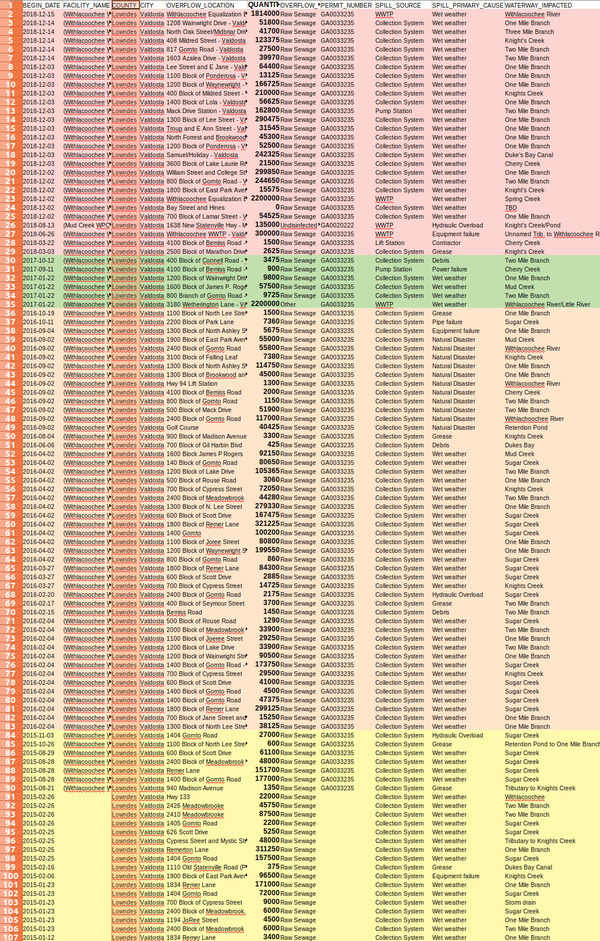
Sewage spills in the Suwannee River Basin 2015-2018.I told them as recently as last summer I was at least able to say that the Valdosta sewage situation was improving, but not after December 2018: more than four million gallons of raw sewage in one month is not improvement. (It turns out even that was low. Valdosta’s total for its last big WWTP spill ran the total over six million gallons.)
I wondered whether being a subject of legislative committees in Tallahassee and of GA-EPD in Atlanta was really what Valdosta wanted to be famous for?
-
7. Still working on wastewater –Sandra Tooley

Video. Mayor Pro Tem Sandra Tooley said God keeps testing Valdosta with rain, and Valdosta would keep working on wastewater.
-
7. Thanks, Florida speaker –Tim Carroll

Video. Council Tim Carroll thanked the Florida speaker for coming to speak.
After the January Council meeting
After the meeting, Merrillee Malwitz-Jipson discussed with Utilities Director Darryl Muse quite a bit. She did not actually recognize him from the tour of Valdosta’s wastewater plants he organized last October at WWALS’ request; I reminded her later.
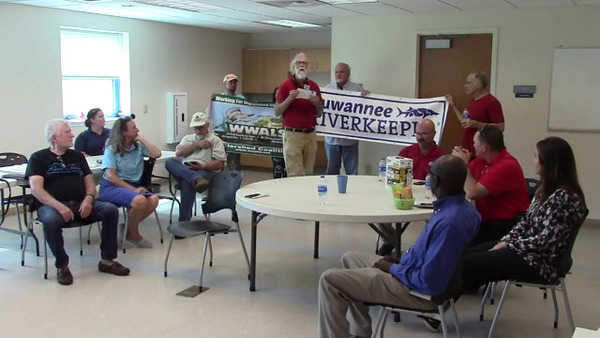
Debrief after
Tour of Valdosta WTPs 2018-10-03.
I did recognize Director Muse, and I made a point of saying he didn’t cause these problems, and he’s trying to fix them.
Merrillee knows, but others in Florida may not: Darryl Muse came to Valdosta from Ocala, Florida, so he is familiar with Florida conditions. Muse is not, however, familiar with the Suwannee River Basin; last October he thought Gainesville was in it.
According to Florida’s Public Notices of Pollution, Gainesville, Florida, also has frequent wastewater spills, although maybe not so frequent or so large as Valdosta, Georgia. But that doesn’t help people in the Suwannee River Basin. Both Valdosta and Gainesville need to clean up their acts.
BMAPs are a different, but much bigger problem
Director Muse also noted that Florida’s Basin Management Action Plans for the Suwannee River Basin show sewage as less than one percent of the problem with contamination in springs and rivers. This is true, but irrelevant. Nitrate leaching into springs does not cause the kinds of direct human health risks that raw sewage does. Nitrate leaching also does not cause Florida health departments to post public warnings, causing people to get off the rivers, adversely affecting economy and everything else downstream.
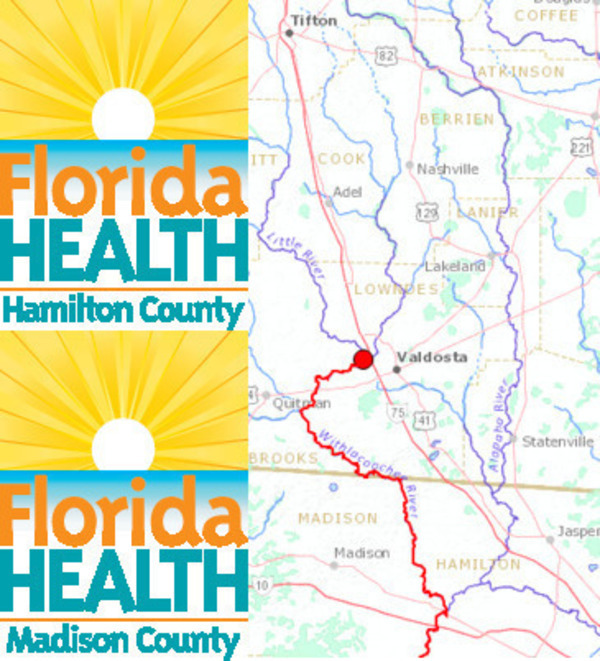
Map:
USGS Streamer.
The BMAPs are not irrelevant to downstream Florida counties. They are actually much more important than Valdosta’s wastewater, affecting as they do the health of all the streams and springs much farther downstream than any sewage from Valdosta will ever reach, and requiring large changes in how agriculture is done in the Suwannee River Basin.
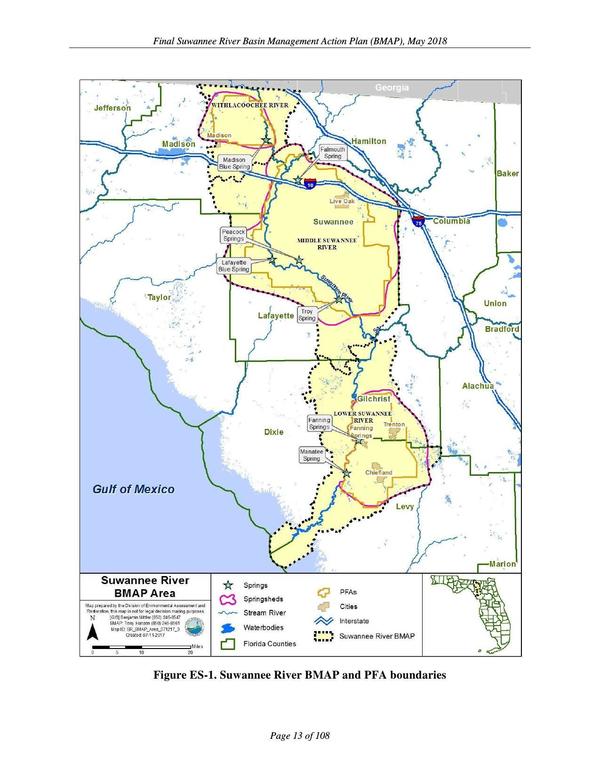
Final Suwannee River BMAP 2018-05-22.
Or could require that, if the BMAPs had any teeth, which they don’t: no new remediation measures (just the same old Best Management Practices (BMPs) that haven’t improved the situation in decades, and no fines or other measures if there is not improvement. While the River Task Force members have the ear of the Florida legislature, they should consider taking up putting teeth into the BMAPs.
More Water Quality Testing needed
Director Muse also mentioned that Valdosta’s own water quality sampling often shows more bacterial contamination upstream of their wastewater treatment plants than downstream.
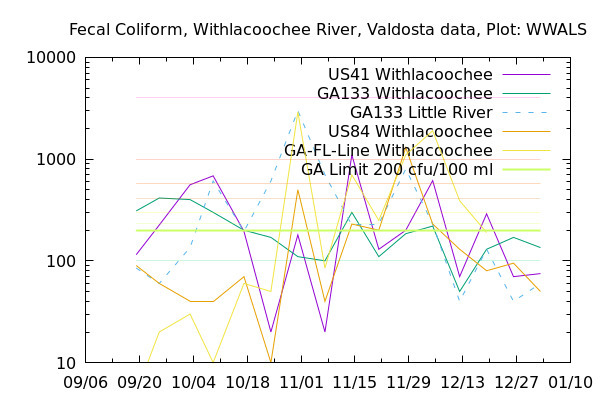
Still below the limit: fecal coliform in Valdosta river data 2019-01-02.
This is why we need more water quality testing: regular, frequent, at closely-spaced intervals along all the rivers. WWALS is doing what it can, but more is needed, especialy now that Valdosta has dropped back from weekly to monthly testing.
Room for Improvement
I don’t think previous Utilities Director Henry Hicks caused these problems, either. Hicks oversaw the tens of millions of dollars of sewer system improvements that Darryl Muse is now polishing, including a new Withlacoochee Wastewater Treatment Plant and new force main.

Mayor Gayle, Henry Hicks, and others with Hamilton County citizens about Valdosta wastewater, 2015-03-17.
These problems go back more to Valdosta’s boom days a decade and more ago, when Valdosta encouraged massive population growth without upgrading its sewer infrastructure to deal with it. Valdosta’s wastewater woes were one of the main reasons for the formation of WWALS Watershed Coalition in June 2012, and many of us who formed WWALS were already following the problem before then.
However the problem got started, there is more to be done to fix it. Spilling more than six million gallons of raw sewage in the one month of December 2018 is not improvement.
Here’s a WWALS video playlist:
Wastewater at Valdosta City Council, Winter 2018-2019
Videos by John S. Quarterman for Lowndes Area Knowledge Exchange (LAKE).
For much more context and ways you can help, see wwals.net/issues/vww/.
-jsq, John S. Quarterman, Suwannee RIVERKEEPER®
You can join this fun and work by becoming a WWALS member today!
Short Link:
